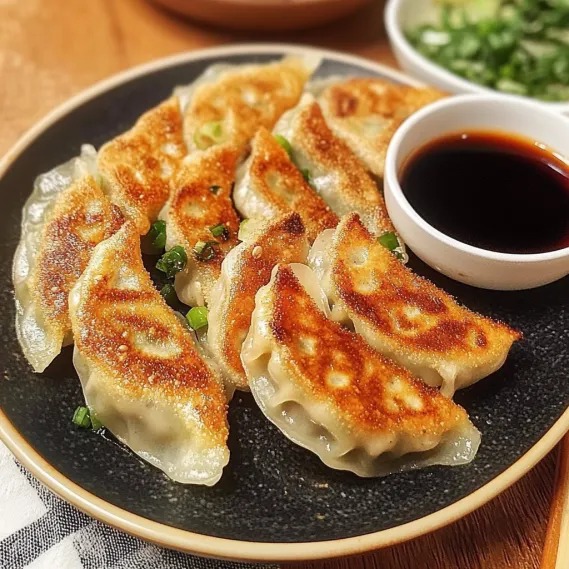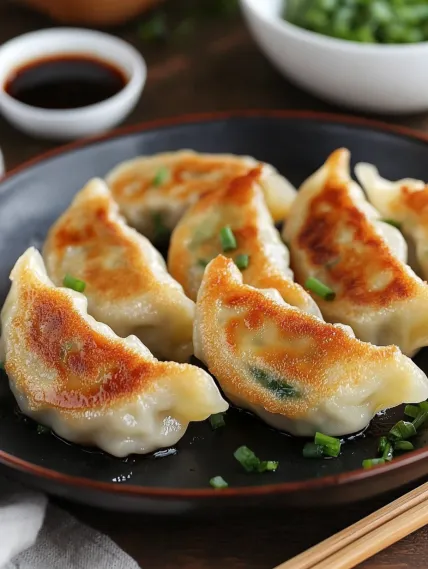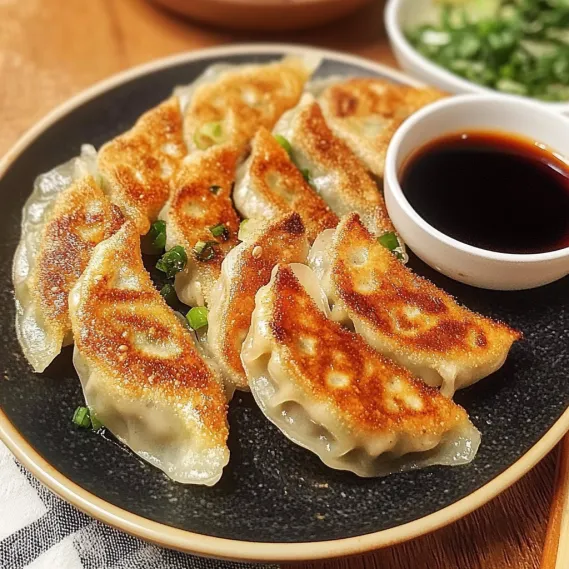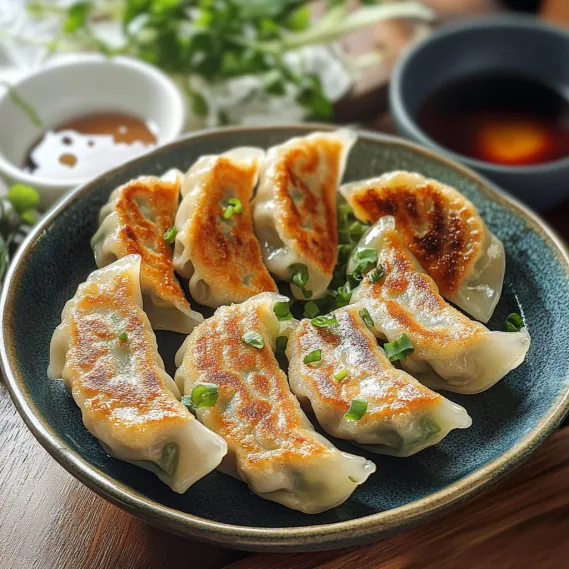 Pin it
Pin it
Homemade Japanese prawn gyoza gives you dumplings with crunchy bottoms stuffed with juicy prawns, crisp cabbage, and flavorful chives. These tasty little bundles nail the balance between their golden crunchy base and soft, flavorful insides. You'll taste savory goodness in every bite, perfectly matched with the tangy dipping sauce. Making these at home brings real Japanese tastes to your kitchen with easy methods that turn out just like what you'd get at a restaurant.
My neighbor who spent a few years living in Japan taught me how to make these dumplings. I couldn't believe how something that seemed so fancy in restaurants was actually so simple to make at home. The first time I made them for my family, my brother-in-law (who never says nice things about my cooking) wondered if I'd bought them from the Japanese place down the street. That's when I knew I'd nailed it.
Key Ingredients and Shopping Advice
- Gyoza Wrappers: They're made from wheat flour, salt, and water. These come smaller and thinner than Chinese dumpling wrappers. You'll find them in the cold section at Asian grocery stores.
- Prawns/Shrimp: Go for fresh or frozen ones, already peeled and cleaned. If you're using frozen, make sure they're completely thawed and dried before chopping.
- Garlic Chives: These have a strong, garlicky smell that's perfect for dumplings. Can't find them? Regular chives or green onions work too.
- Cabbage: Asian or sweetheart cabbage with its thin, soft leaves works best here. Napa cabbage makes a good backup option.
- Seasonings: The real trick is getting the right mix of soy sauce, sesame oil, mirin, garlic, and ginger that turns basic ingredients into something amazing.
I've learned that squeezing the cabbage properly really changes how the final dumpling turns out. The first time I rushed and didn't dry it enough, my filling was too wet and tore through the wrappers while cooking. Now I always make sure the cabbage is as dry as possible before mixing it with everything else.
Step-by-Step Cooking Guide
- Step 1: Mix Up Your Filling
- Chop the cabbage finely and toss it with salt, then let it sit for 10-15 minutes. While waiting, dry off the prawns and chop them up small with a knife or pulse them quickly in a food processor. Squeeze all the water out of the cabbage with your hands, then mix it with the prawns and finely chopped chives.
- Step 2: Add All The Tasty Stuff
- Put in 1 tablespoon soy sauce, 1 tablespoon sesame oil, 1 tablespoon mirin, 2 cloves of minced garlic, and 1 teaspoon grated ginger to your prawn mix. Add 1 tablespoon cornstarch to help everything stick together, then stir it all up until it gets a bit sticky and holds its shape.
- Step 3: Get The Folding Down
- Hold a gyoza wrapper in your hand, put a tablespoon of filling in the middle, and wet the edges with some water. Fold it in half over the filling, then make little folds along one edge by pinching and folding, working your way across while pressing firmly to seal.
- Step 4: Cook Them Just Right
- Heat up a tablespoon of oil in a non-stick pan over medium heat. Put your gyoza in with the pleated side facing up, making sure they don't touch each other. Cook until the bottoms turn golden (about 2 minutes), then pour in 1/3 cup water and quickly cover the pan. Let them steam for 3-4 minutes until the water's gone.
- Step 5: Get That Final Crunch
- After the water disappears, let the gyoza cook uncovered for another minute to get the bottoms extra crispy. Put them on a serving plate with the crispy side facing up, and serve right away with a dipping sauce made from equal parts soy sauce and rice vinegar plus a little chili oil.
 Pin it
Pin it
When I first tried making this recipe, the folding part really scared me. After several wonky-looking attempts, I figured out that simple folds taste just as good as fancy ones - they're delicious either way. These days my kids help with the folding, coming up with their own styles that have become our family's special touch.
Stunning Texture Tricks
What makes gyoza special is that mix of crunchy bottoms and soft tops. I've found that controlling moisture at every step is crucial. First, you've gotta squeeze that salted cabbage really well to get rid of extra water that would make your filling soggy. Next, the cornstarch doesn't just hold everything together - it soaks up any leftover moisture too. Finally, that cooking method - frying, then steaming, then frying again - creates that awesome crispy bottom while making sure the filling cooks through perfectly.
 Pin it
Pin it
Prep Ahead Tricks for Easy Entertaining
One thing that makes gyoza so awesome is you can make them ahead of time. I often spend Sunday afternoons making twice as many, freezing half for later. Just put your uncooked gyoza on a baking sheet with parchment paper, freeze them solid, then toss them in freezer bags. They'll stay good for up to three months and can go straight from freezer to pan - just add another minute to the steaming time. This way I can pull out homemade dumplings even on busy weeknights or when friends drop by unexpectedly.
Try These Sauce Twists
The basic dipping sauce tastes great, but I've tried several different versions that my family now loves. For something sweeter, mix a teaspoon of honey into the regular sauce. When cooking for people who love spicy food, I add extra chili oil and a bit of Sichuan peppercorn for that tingly heat. For more complex flavors, try adding some finely chopped garlic and a splash of rice vinegar. My personal favorite for summer get-togethers includes fresh chopped cilantro and a squeeze of lime juice, which adds a fresh brightness that goes really well with the rich dumplings.
Tasty Side Dish Ideas
Make your gyoza into a complete meal with some good side dishes. For a true Japanese experience, serve them with simple miso soup and plain steamed rice. When having guests over, I put together an Asian-inspired spread with cucumber salad dressed in rice vinegar, sesame oil, and sugar, plus some edamame sprinkled with sea salt. For a mix of cuisines that's always popular at parties, serve gyoza alongside Korean kimchi, which gives a spicy kick that balances out the delicate dumpling flavors. These dumplings are so versatile they work great as part of a big Asian feast or as the main star of a quick weeknight dinner.
 Pin it
Pin it
Smart Kitchen Tricks
- For extra juicy filling, chop your prawns by hand instead of over-blending them
- If dumplings stick to the pan, let them cool a bit - they'll come off easier
- Go with a non-stick pan that has a lid that fits tightly
- Try using a small ice cream scoop to measure filling for perfectly even dumplings
- When serving, arrange your gyoza in a circle with the crispy sides facing out for a fancy look
Frequently Asked Questions
- → Can I store these dumplings in the freezer?
- Sure! Freeze raw gyoza on parchment-lined trays for 1 hour, then pop them into a bag and keep frozen for up to a month.
- → How do I warm up leftover dumplings?
- They're at their best freshly cooked, but you can warm them up quickly in the microwave until heated through.
- → What can I use instead of prawns?
- You can swap the prawns with ground chicken, pork, or diced firm tofu without any issue.
- → Where can I buy gyoza skins?
- Check an Asian, Japanese, or Chinese grocery store’s chilled or frozen sections for gyoza wrappers.
- → Why do we sprinkle salt on the cabbage?
- Salting removes extra water from the cabbage, so the filling stays firm and doesn't get soggy.
